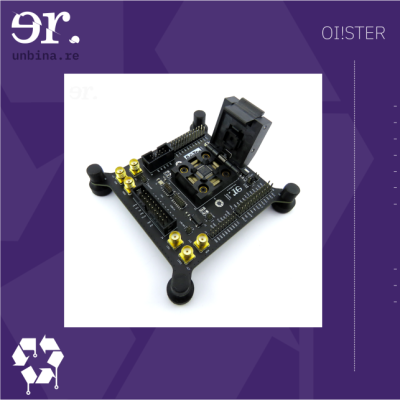Unbinare is a small Belgian company at the forefront of hacking e-waste into something useful, collaborating with recycling and refurbishing companies. Reverse-engineering is a novel way to approach recycling, but it’s arguably one of the most promising ways that we are not trying at scale yet. At Hackaday Remoticon 2021, Maurits Fennis talked about Unbinare’s efforts in the field and presented us with a toolkit he has recently released as a part of his work, as well as described how his background as an artist has given him insights used to formulate foundational principles of Unbinare.
 Unbinare’s tools are designed to work in harmony with each other, a requirement for any productive reverse-engineering effort. OI!STER is a general-purpose salvaged MCU research board, with sockets to adapt to different TQFP chip sizes. This board is Maurits’s experience in reverse-engineering condensed into a universal tool, including a myriad of connectors for different programming/debugging interfaces. We don’t know the board’s full scope, but the pictures show an STM32 chip inside the TQFP socket, abundant everywhere except your online retailer of choice. Apart from all the ways to break out the pins, OI!STER has sockets for power and clock glitching, letting you target these two omnipresent Achilles’ heels with a tool like ChipWhisperer.
Unbinare’s tools are designed to work in harmony with each other, a requirement for any productive reverse-engineering effort. OI!STER is a general-purpose salvaged MCU research board, with sockets to adapt to different TQFP chip sizes. This board is Maurits’s experience in reverse-engineering condensed into a universal tool, including a myriad of connectors for different programming/debugging interfaces. We don’t know the board’s full scope, but the pictures show an STM32 chip inside the TQFP socket, abundant everywhere except your online retailer of choice. Apart from all the ways to break out the pins, OI!STER has sockets for power and clock glitching, letting you target these two omnipresent Achilles’ heels with a tool like ChipWhisperer.
No tool like OI!STER stands alone. The UNBRK is a breakout board for more permanent and tailored reverse-engineering fixtures, with traces and power planes intricately laid out for unparalleled universality for reusing all kinds of ICs. Ad-hoc probing of various signals is still a must even with a purpose-built fixture, and the UNBProbe is a testpoint probe with an optional nifty 3D-printed case, designed with usability and ease of independent assembly in mind. Once you use too many of these probes in one project, you’ll definitely want to build yourself a UNBProbeBase, a mother-board for grouping a bunch of UNBProbes together into one comfortable connector – otherwise, the cables expand to occupy all the space available to them, distracting you from today’s RE puzzle and bothering you with an unsolicited topology exercise.
Whether hacking for the purpose of recycling or simply freeing your devices to do with them what you wish, Unbinare’s tools are equal parts useful and beautiful, and this work extends to other resources like a Wiki page for documenting their efforts and sharing tool designs. If you’d like to keep yourself updated on their next milestones, your best bet would be following them on Twitter for whenever the next tool and project announcements get dropped!
0 Commentaires